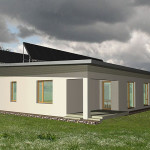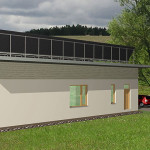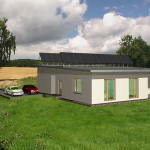TECHTRANS PT s.r.o. include in their projection a PLUS house (energetically active construction with yearly surplus energy) for the family, about 150 m², barrier-free, fully equipped with solar collectors.
Low-Energy PLUS House
conceptual design – Ing. Vaclav Prech, TECHTRANS PT
architectural design – Ing. arch. Bretislav Kubicek
Karlovy Vary Eco-centre
Stara Role – Nadrazni Str. ground plot No. 110/1
conceptual design – Ing. Vaclav Prech, TECHTRANS PT
architectural design – Ing. arch. Bretislav Kubicek
Solution proposal for the common heating of both existing and new building areas of regenerative thermal sources
Intention
The consideration shows how important the connection of the existing house-building with the new house-building planned to be executed in the active power PLUS type may be. The PLUS houses or, in other words, energetically active houses, are constructions which show surplus energies in their annual balances.
Central heat supply (CHS)
The existing house-building is thermally interconnected with the new house-building by means of a common distribution network with a central source to the regenerative energy. The central source may also be solved in terms of combined heat and power.
Connected to the common CHS network are the decentralised collector sources that are installed predominantly on the PLUS houses but, if possible, in other convenient localities as well, for instance, on the roof of the boiler house, fuel bin,…
Sufficient accumulation capacity is required for the economical and efficient distribution of heat. It is predominantly the decentralised storage-type heat transfer stations (PAST) that overlay both the intake and extraction peaks where subscribers and the central heat accumulator that provides for smooth operation of the central thermal source are connected.
The PLUS houses are fully equipped with solar collectors that may be profitably fitted with a mechanism changing their inclination angle for optimum summer and winter operation. The surplus heat is then taken away into a common network to be consumed in the old development area.
Electrical wiring
The surplus electrical energy from photovoltaic collectors is usually supplied into an already existing electrical network according to the state-of-the-art and legislative provisions.
Advantages for the old development area
- attainment of up to a total heat supply from regenerative sources
- stabilisation of the price for energy
- reduction of dependency on foreign energy
- reduction in environmental burden
- increase in the heating standard
- satisfactory solution in terms of monument preservation
Advantages for the new development area
- utilisation of surplus heat in the common network
- capacity saving of the decentralised heat accumulators
- provision of thermal redundancy from the central source
Advantages for the central source and distribution network
- saving in fuel mainly due to the application of solar collectors
- reduction and stabilisation of the price for heat by using own resources
- efficient central filtering of flue gases
- possibility of intelligent control with, for example, the possibility to make use of the weather forecast
- creation of new job possibilities
Hybrid solution
As stated above, the connection of the new and existing development areas forms advantageous conditions for all the subscribers.
The solution shows not only the needed ecological advantages but also an economical solution to achieve the common objectives resulting from the company’s vital interests – heading towards progress on the direction to reach power engineering transformation.
Significance of energy saving
The energy gains in the field of fuel and hot water heating are extraordinarily significant. Indeed, the share in the total primary energy consumption amounts to 40 to 50% in this sector. It is the greatest share in the primary energy consumption ever.
Savings in biomass
A further goal is to attain the maximum possible savings of the increasing regenerative source – obtaining the maximum possible share in the collector solar source.
However, the limit value of the installed solar collector area is limited by hot water consumption in a non-heating season, that is, mainly by the number of people making use of the network.
In the first approximation, a reference value can be taken into account of about 2.5 to 3 m² of the installed collector area in the network per 1 person if the system is not to be overheated.
The power engineering transformation in the field of heating
The stated hybrid solution shows the possible way to full substitution of fossil sources with regenerative sources, in certain cases also in the already existing or even historical development areas.
Expensiveness
The investment expensiveness of PLUS houses connected to a common network will remain within the usual limits of structures of comparable utility.
The PLUS houses that are not connected to the common thermal network would need extraordinarily large heat accumulators to operate in a natural yearly cycle. Their size would then exceed a water capacity of 50 m³ per house; however, such capacity is not needed in the CHS operation.
Another possibility to achieve energetic activity
The constructions without a common thermal network can be connected to a common electrical network. Then a solar-energy power station would usually be installed instead of a solar-energy heating plant. Thermal collectors would cover only the heat consumption in the non-heating season. Thermal deficit in the heating season would be compensated by the backup source.
It must be remembered that the efficiencies of thermal collectors are several times higher when compared to those of electrical collectors.
Pilot Project
The proposed hybrid solution has general significance in principle.
Thus, the establishment of the Pilot Project is presumed with general participation and support, aimed at both verifying and specifying the possible operational values and properties of the system and finding the Project’s further developmental potential.
A legal form needs to be determined then for the operation of such small decentralised solar-energy heating plants within the operation of a common network.
State of the art
The principles of active houses’ conceptual designs are known at present and their energy objectives are already proven in practice.
What is in question is always the significantly low-energy constructions with a high passive and active utilisation of solar energy and an efficient accumulation of heat.
The solutions for CHS into regenerative energy inclusive of the distribution networks and the storage-type heat transfer stations are also sufficiently known and well-tested.
Innovation
The innovation of the given hybrid solution consists mainly in a new principle for convenient connection of existing development areas with the energetically active construction by using the common heating distribution system with a central source for regenerative energy.
Reasoning to the discussion on carbon oxides emissions
Environmental burden
Fossil power engineering weighs on the environment in a serious manner. It is predominantly a burden of chemical, radioactive and thermal character. Let us not forget the following minimum:
- Acidification and intoxication of soil, waters, and organisms.
- Contamination of the environment with radioactive substances from all fossil sources.
- Consequent changes in climate.
Nuclear sources are also included among exhaustible fossil (mined from the Earth) resources.
Total transformation of power engineering
Irrespective of the serious consequences on an environment burdened with fossil sources, no other goal may be set than the total transformation of fossil power engineering into regenerative power engineering for reasons of exhaustibility.
This transformation is therefore irreversible.
Any counterarguments are useless and counterproductive.
Power engineering transformation process
First of all, successful transformation must be timely and accompanied by efforts to save energy. That means efficient processes must be increased and the useless, energy consuming activities must be reduced.
What is beneficial for speeding up the transformation is a predominantly progressive tax policy in the field of energy consumption and environmental burden.
Transformation development and necessary technique advancement must be supported.
The only effective method to control the fossil sources’ reduction up to their total disqualification is the control of their exploitation. Exploitation can be localised and measured.
The transformation must be co-sponsored from tax incomes, predominantly according to the degree of prospect for its complete attainment.
Energy paradigm
The era of fossil power engineering that is linked with advancement of the industrial revolution ends here, to change into regenerative power engineering again, however, at a new developmental stage in a new paradigmatic period.
This transition affects all areas of human activities.
Conclusion
The given complex solution for fuel and hot water heating using regenerative sources for the existing and new developmental areas is one of many necessary steps on the way to a complete reconstruction of power engineering.
Author: Ing. Václav Prech, TECHTRANS PT s.r.o.





